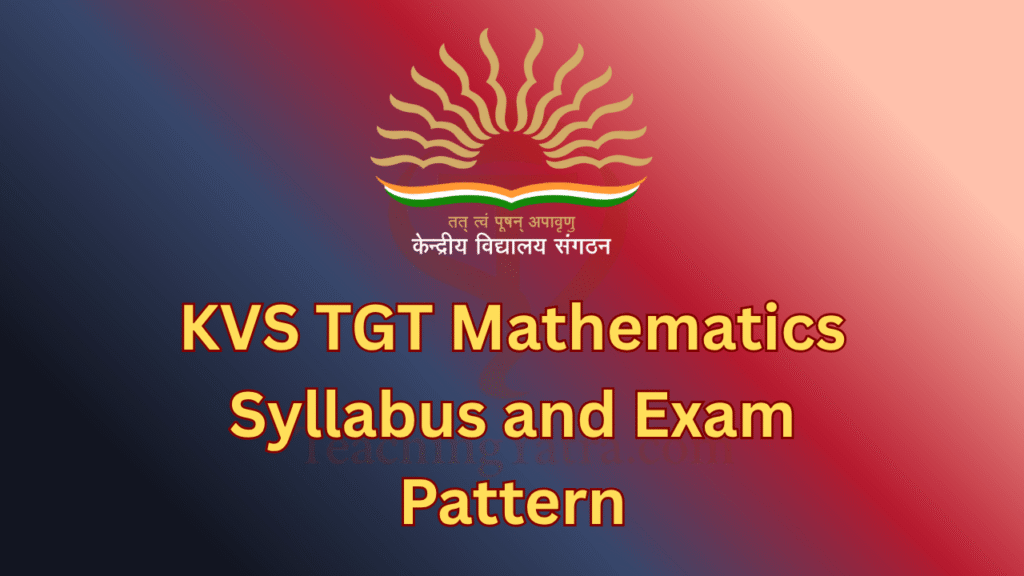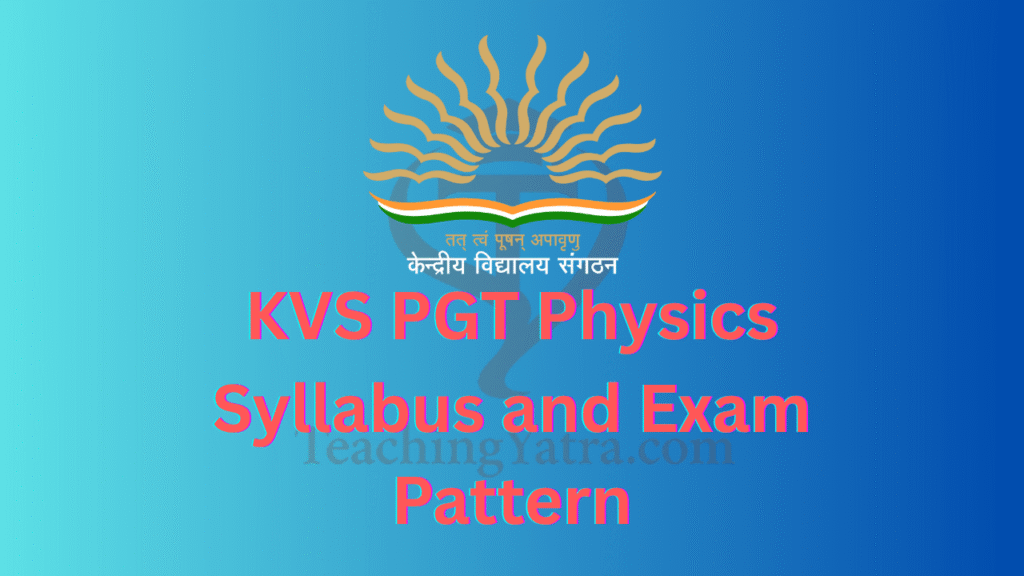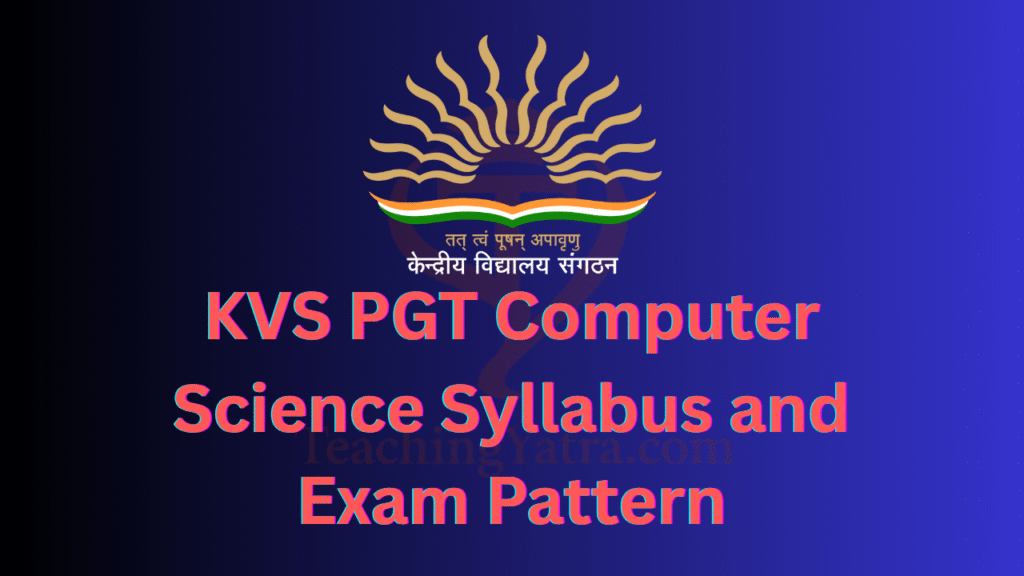
The KVS TGT Mathematics Syllabus and Exam Pattern 2025 serves as a comprehensive guide for candidates preparing to become Trained Graduate Teachers (TGT) in Mathematics under Kendriya Vidyalaya Sangathan (KVS). Understanding the updated syllabus and exam structure is essential for targeted preparation and success in the recruitment process. This document outlines the key topics, subject-wise weightage, and the exam pattern to help aspirants develop a focused study plan. With a strong foundation in mathematics concepts and a strategic approach aligned with the syllabus, candidates can enhance their performance and secure a teaching position in one of India’s most reputed educational institutions.
Table of Contents
KVS TGT Mathematics Syllabus 2025: Overview
The Kendriya Vidyalaya Sangathan (KVS) has released the TGT Mathematics Syllabus 2025, which outlines the essential topics and exam structure for candidates aspiring to become Trained Graduate Teachers (TGT) in Mathematics
The KVS TGT Mathematics Syllabus 2025 outlines the topics and structure of the exam for candidates aspiring to become Trained Graduate Teachers in Mathematics. The exam consists of four parts: language proficiency (English and Hindi), general awareness with reasoning and computer literacy, perspectives on education and leadership, and subject-specific mathematics. The mathematics section carries the highest weightage with 100 marks and includes topics from the NCERT syllabus of classes 6 to 10 such as real numbers, polynomials, equations, geometry, trigonometry, mensuration, and statistics. The paper has a total of 180 multiple-choice questions, to be completed in 3 hours, and is conducted in both English and Hindi. Understanding the syllabus helps candidates plan their preparation strategically for better results.
KVS TGT Mathematics Exam Pattern 2025
The KVS TGT Mathematics Exam 2025 consists of 180 multiple-choice questions carrying a total of 180 marks, to be completed in 3 hours. The exam is divided into four parts. Part I tests language proficiency through General English and General Hindi. Part II assesses General Awareness, Reasoning Ability, and Computer Literacy. Part III focuses on Perspectives on Education and Leadership, which includes topics like child development, inclusive education, and teaching-learning processes. Part IV evaluates the candidate’s subject knowledge in Mathematics, covering topics such as algebra, geometry, trigonometry, statistics, and mensuration. The exam is bilingual (English and Hindi) and aims to test both teaching aptitude and subject expertise.
KVS TGT Mathematics Exam Pattern & Marks Distribution
| Part | Subject | No. of Questions | Marks |
|---|---|---|---|
| Part I | General English | 10 | 10 |
| General Hindi | 10 | 10 | |
| Part II | General Awareness & Current Affairs | 10 | 10 |
| Reasoning Ability | 5 | 5 | |
| Computer Literacy | 5 | 5 | |
| Part III | Perspectives on Education & Leadership | 40 | 40 |
| Part IV | Subject Concerned (Mathematics) | 100 | 100 |
| Total | 180 | 180 |
Detailed KVS TGT Mathematics Syllabus 2025
Subject specific syllabus includes the concepts of NCERT/CBSE syllabus and Text Books (Classes VI to X), however, the questions will be testing the depth of understanding and application of these concepts at the level of Graduation
REAL NUMBERS
• Review of representation of natural numbers, integers, and rational numbers on the number line. Rational numbers as recurring/terminating decimals. Operations on real numbers.
• Examples of non-recurring/non-terminating decimals. Existence of non-rational numbers (irrational numbers) such as √2, √3, and their representation on the number line.
• Explaining that every real number is represented by a unique point on the number line and conversely, viz. every point on the number line represents a unique real number.
• Definition of nth root of a real number.
• Rationalization of real numbers of the type 1/a+b√x and 1/√x+√y their combinations where x and y are natural numbers and a and b are integers.
• Laws of exponents with integral powers. Rational exponents with positive real bases.
• Fundamental Theorem of Arithmetic statements after reviewing work done earlier and after illustrating and motivating through examples.
• Proofs of irrationality of √2, √3, √5
POLYNOMIALS
• Definition of a polynomial in one variable, with examples and counterexamples.
• Coefficients of a polynomial, terms of a polynomial and zero polynomial.
• Degree of a polynomial. Constant, linear, quadratic and cubic polynomials. Monomials, binomials, trinomials. Factors and multiples.
• Zeros of a polynomial. Relationship between zeros and coefficients of quadratic polynomials.
• Remainder Theorem with examples, Factor Theorem.
• Factorization of ax² + bx + c, a ≠ 0 where a, b and c are real numbers, and of cubic polynomials using the Factor Theorem.
• The algebraic expressions and identities. Verification of identities
(x + y + z)² = x² + y² + z² + 2xy + 2yz + 2zx
(x ± y)³ = x³ ± y³ ± 3xy(x ± y)
x³ ± y³ = (x ± y)(x² ∓ xy + y²)
x³ + y³ + z³ − 3xyz = (x + y + z)(x² + y² + z² − xy − yz − zx)
and their use in factorization of polynomials.
LINEAR EQUATIONS IN TWO VARIABLES
• Linear equations in one variable. Introduction to the equation in two variables.
• Focus on linear equations of the type ax + by + c = 0.
• Explain that a linear equation in two variables has infinitely many solutions and justify their being written as ordered pairs of real numbers, plotting them and showing that they lie on a line.
• Subject-specific syllabus includes the concepts of NCERT/CBSE syllabus and Text Books (Classes VI to X), however, the questions will be testing the depth of understanding and application of these concepts at the level of Graduation.
PAIR OF LINEAR EQUATIONS IN TWO VARIABLES
• Pair of linear equations in two variables and graphical method of their solution, consistency/inconsistency.
• Algebraic conditions for number of solutions.
• Solution of a pair of linear equations in two variables algebraically – by substitution, by elimination.
• Simple situational problems.
QUADRATIC EQUATIONS
• Standard form of a quadratic equation ax² + bx + c = 0, (a ≠ 0).
• Solutions of quadratic equations (only real roots) by factorization and by using quadratic formula.
• Relationship between discriminant and nature of roots.
ARITHMETIC PROGRESSIONS
• Arithmetic Progression, nth term and sum of the first n terms of A.P. and their application in solving daily life problems.
COORDINATE GEOMETRY
• The Cartesian plane, coordinates of a point, names and terms associated with the coordinate plane, notations.
• Graphs of linear equations.
• Distance formula.
• Section formula (internal division).
INTRODUCTION TO EUCLID’S GEOMETRY
• History – Geometry in India and Euclid’s geometry.
• Euclid’s method of formalizing observed phenomenon into rigorous Mathematics with definitions, common/obvious notions, axioms/postulates and theorems.
• The five postulates of Euclid.
• Showing the relationship between axiom and theorem.
• (Axiom) 1. Given two distinct points, there exists one and only one line through them.
• (Theorem) 2. Two distinct lines cannot have more than one point in common.
LINES AND ANGLES
• If a ray stands on a line, then the sum of the two adjacent angles so formed is 180 degrees and the converse.
• If two lines intersect, vertically opposite angles are equal.
• Lines which are parallel to a given line are parallel.
TRIANGLES
• SAS, ASA, SSS, RHS congruence criteria.
• Angles opposite to equal sides of a triangle are equal.
• Sides opposite to equal angles of a triangle are equal.
• Basic Proportionality Theorem and its converse.
• Criteria for similarity of triangles using angle and side properties.
QUADRILATERALS
• Diagonal divides a parallelogram into two congruent triangles.
• Opposite sides and angles of a parallelogram are equal, and converse.
• A quadrilateral is a parallelogram if a pair of its opposite sides is parallel and equal.
• Diagonals of a parallelogram bisect each other and converse.
• Midpoint theorem and its converse.
CIRCLES
• Equal chords subtend equal angles at the center and converse.
• Perpendicular from center bisects the chord and converse.
• Equal chords are equidistant from the center and converse.
• Angle subtended by arc at center is double that subtended at any other point.
• Angles in the same segment are equal.
• Cyclic quadrilateral properties: opposite angles are supplementary and converse.
• Tangents to a circle: point of contact, perpendicularity to radius, equality of lengths from an external point.
AREAS
• Area of a triangle using Heron’s formula.
• Area of sectors and segments of a circle (central angle 60°, 90°, 120°).
• Problems on areas and perimeter/circumference.
SURFACE AREAS AND VOLUMES
• Surface areas and volumes of spheres (including hemispheres) and right circular cones.
• Surface areas and volumes of combinations of two solids: cubes, cuboids, spheres, hemispheres, cylinders, cones.
STATISTICS
• Bar graphs, histograms (with varying base lengths), frequency polygons.
• Mean, median, mode of grouped data.
PROBABILITY
• Classical definition of probability.
• Simple problems on finding the probability of an event.
TRIGONOMETRY
• Trigonometric ratios of an acute angle of a right-angled triangle.
• Proof of existence (well-defined); motivate ratios at 0° and 90°.
• Values of trigonometric ratios of 30°, 45°, and 60°.
• Relationships between the ratios.
TRIGONOMETRIC IDENTITIES
• Proof and applications of the identity sin²A + cos²A = 1.
• Only simple identities to be given.
HEIGHTS AND DISTANCES
• Angle of elevation, angle of depression.
• Simple problems involving no more than two right triangles.
• Angles involved: 30°, 45°, and 60°.
Detailed KVS TGT Mathematics Syllabus 2025 in Hindi
विषय-विशिष्ट पाठ्यक्रम में एनसीईआरटी/सीबीएसई पाठ्यक्रम और पाठ्यपुस्तकों (कक्षा 6 से 10 तक) की अवधारणाएँ शामिल हैं। हालांकि, प्रश्न इन अवधारणाओं की गहराई से समझ और उनके अनुप्रयोग को स्नातक स्तर पर परखने के लिए होंगे।
वास्तविक संख्याएँ (Real Numbers)
• प्राकृतिक संख्याओं, पूर्णांकों और परिमेय संख्याओं को संख्या रेखा पर दर्शाने की समीक्षा। परिमेय संख्याएँ आवर्ती/समाप्त दशमलव के रूप में। वास्तविक संख्याओं पर संक्रियाएँ।
• अनावर्ती/असमाप्त दशमलव के उदाहरण। √2, √3 जैसे अपरिमेय संख्याओं का अस्तित्व और संख्या रेखा पर उनका निरूपण।
• यह स्पष्ट करना कि हर वास्तविक संख्या संख्या रेखा पर एक अद्वितीय बिंदु द्वारा निरूपित होती है और इसके विपरीत भी।
• वास्तविक संख्याओं का nवाँ मूल (nth root) की परिभाषा।
• इस प्रकार की वास्तविक संख्याओं का परानुकरण: 1/(a + b√x), 1/(√x + √y) (जहाँ x, y प्राकृतिक संख्याएँ हैं और a, b पूर्णांक)।
• पूर्णांक घातों वाले घातांक के नियम। धनात्मक वास्तविक आधार वाले परिमेय घातांक।
• अंकगणित का मौलिक प्रमेय – पहले किए गए कार्य की समीक्षा के बाद कथन, उदाहरणों से प्रेरणा।
• √2, √3, √5 के अपरिमेयता के प्रमाण।
बहुपद (Polynomials)
• एक चर वाले बहुपद की परिभाषा, उदाहरण और प्रतिउदाहरण।
• बहुपद के गुणांक, पद और शून्य बहुपद।
• बहुपद की डिग्री। स्थिरांक, रैखिक, द्विघात और घन बहुपद। एकपदी, द्विपदी, त्रिपदी। गुणनखंड और गुणज।
• बहुपद के शून्य। द्विघात बहुपदों के शून्य और गुणांकों के बीच संबंध।
• शेषफल प्रमेय (Remainder Theorem) और गुणनखंड प्रमेय (Factor Theorem) के उदाहरण।
• ax² + bx + c (जहाँ a ≠ 0) के गुणनखंडन और घन बहुपदों का गुणनखंड प्रमेय से हल।
• बीजीय व्यंजक और सर्वनाम। सर्वनामों की पुष्टि:
(x + y + z)² = x² + y² + z² + 2xy + 2yz + 2zx
(x ± y)³ = x³ ± y³ ± 3xy(x ± y)
x³ ± y³ = (x ± y)(x² ∓ xy + y²)
x³ + y³ + z³ − 3xyz = (x + y + z)(x² + y² + z² − xy − yz − zx)
और इनका उपयोग बहुपदों के गुणनखंडन में।
दो चरों वाले रैखिक समीकरण
• एक चर वाले रैखिक समीकरण। दो चरों वाले समीकरण का परिचय।
• ax + by + c = 0 प्रकार के रैखिक समीकरणों पर केंद्रित।
• यह समझाना कि दो चरों वाले रैखिक समीकरण के अनंत समाधान होते हैं, इन्हें क्रमबद्ध युग्म के रूप में व्यक्त किया जा सकता है, उन्हें प्लॉट कर यह दिखाना कि ये एक रेखा पर स्थित होते हैं।
• विषय-विशिष्ट पाठ्यक्रम में कक्षा VI से X तक की NCERT/CBSE पुस्तकों की अवधारणाएँ शामिल हैं, लेकिन प्रश्न इनकी समझ और उपयोग को स्नातक स्तर पर परखने के लिए होंगे।
दो चरों वाले रैखिक समीकरणों के युग्म
• दो चरों वाले समीकरणों के युग्म और उनका ग्राफीय हल, सुसंगतता / असुसंगतता।
• हल की संख्या के लिए बीजीय स्थितियाँ।
• उपस्थापन (substitution) और विलोपन (elimination) द्वारा बीजीय हल।
• सरल स्थिति आधारित समस्याएँ।
द्विघात समीकरण (Quadratic Equations)
• द्विघात समीकरण ax² + bx + c = 0 का मानक रूप, (जहाँ a ≠ 0)।
• केवल वास्तविक मूलों वाले समीकरणों का गुणनखंडन और द्विघात सूत्र से हल।
• विवेकांक (discriminant) और मूलों के स्वभाव का संबंध।
अंकगणितीय प्रगति (Arithmetic Progressions)
• अंकगणितीय प्रगति (A.P.), nवाँ पद और पहले n पदों का योग और दैनिक जीवन की समस्याओं में उनका उपयोग।
निर्देशांक ज्यामिति (Coordinate Geometry)
• कार्टेशियन तल, बिंदु के निर्देशांक, संबंधित शब्दावली और संकेत।
• रैखिक समीकरणों के ग्राफ।
• दूरी सूत्र (Distance Formula)।
• विभाजन सूत्र (Section Formula) – आंतरिक विभाजन।
यूक्लिड की ज्यामिति का परिचय
• इतिहास – भारत में ज्यामिति और यूक्लिड की ज्यामिति।
• यूक्लिड की पद्धति – परिभाषाएँ, सामान्य/स्वाभाविक धारणाएँ, स्वयंसिद्ध (axioms), न्याय (theorems)।
• यूक्लिड के पाँच स्वयंसिद्ध।
• स्वयंसिद्ध और न्याय के बीच संबंध दिखाना।
• (स्वयंसिद्ध) 1. दो विभिन्न बिंदुओं के माध्यम से केवल एक रेखा खींची जा सकती है।
• (न्याय) 2. दो विभिन्न रेखाएँ एक से अधिक बिंदु में प्रतिच्छेद नहीं कर सकतीं।
रेखाएँ और कोण (Lines and Angles)
• यदि कोई किरण किसी रेखा पर खड़ी हो तो बने दो सन्निकट कोणों का योग 180° होता है और इसका व्युत्क्रम।
• दो रेखाओं के प्रतिच्छेद करने पर विपरीत कोण बराबर होते हैं।
• यदि कोई रेखा एक रेखा के समानांतर है और दूसरी रेखा भी उसी के समानांतर है, तो वे दोनों परस्पर समानांतर हैं।
त्रिभुज (Triangles)
• सर्वांग समता के मानदंड: SAS, ASA, SSS, RHS।
• समान भुजाओं के सम्मुख कोण बराबर होते हैं।
• समान कोणों के सम्मुख भुजाएँ बराबर होती हैं।
• मूल अनुपात प्रमेय और उसका व्युत्क्रम।
• कोण और भुजाओं के आधार पर त्रिभुजों की समानता के मानदंड।
चतुर्भुज (Quadrilaterals)
• विकर्ण समांतर चतुर्भुज को दो समरूप त्रिभुजों में विभाजित करता है।
• समांतर चतुर्भुज की विपरीत भुजाएँ और कोण समान होते हैं, और इसका व्युत्क्रम भी।
• यदि किसी चतुर्भुज की एक जोड़ी विपरीत भुजाएँ समानांतर और समान हों, तो वह समांतर चतुर्भुज है।
• समांतर चतुर्भुज के विकर्ण एक-दूसरे को समद्विभाजित करते हैं और इसका व्युत्क्रम।
• मध्य बिंदु प्रमेय और उसका व्युत्क्रम।
वृत्त (Circles)
• समान जीवा केंद्र पर समान कोण उत्पन्न करती हैं और इसका व्युत्क्रम।
• केंद्र से जीवा पर डाला गया लंब जीवा को समद्विभाजित करता है और इसका व्युत्क्रम।
• समान जीवा केंद्र से समान दूरी पर होती हैं और इसका व्युत्क्रम।
• चाप द्वारा केंद्र पर उत्पन्न कोण उस चाप द्वारा वृत्त के किसी अन्य बिंदु पर उत्पन्न कोण से दोगुना होता है।
• एक ही खंड में स्थित कोण समान होते हैं।
• समचाप चतुर्भुज के विपरीत कोणों का योग 180° होता है और इसका व्युत्क्रम।
• स्पर्शरेखा से संबंधित तथ्य: संपर्क बिंदु पर स्पर्शरेखा त्रिज्या पर लंब होती है, बाह्य बिंदु से खींची गई स्पर्शरेखाएँ बराबर होती हैं।
क्षेत्रफल (Areas)
• हीरोन सूत्र से त्रिभुज का क्षेत्रफल।
• वृत्त के खंडों और क्षेत्रों का क्षेत्रफल (केवल 60°, 90°, 120° केन्द्र कोण)।
• क्षेत्रफल और परिमाप से संबंधित समस्याएँ।
पृष्ठीय क्षेत्रफल और आयतन (Surface Areas and Volumes)
• गोले (अर्धगोला सहित) और समवृत्त शंकु का पृष्ठीय क्षेत्रफल और आयतन।
• दो ठोसों के संयोजन का क्षेत्रफल और आयतन: घन, घनाभ, गोला, अर्धगोला, बेलन, शंकु।
सांख्यिकी (Statistics)
• स्तंभ चित्र (Bar Graphs), आवृत्ति बहुभुज (Frequency Polygon), विविध आधार लंबाई वाले हिस्टोग्राम।
• समूहीकृत आँकड़ों का औसत (Mean), माध्यिका (Median), बहुलक (Mode)।
प्रायिकता (Probability)
• प्रायिकता की शास्त्रीय परिभाषा।
• किसी घटना की प्रायिकता निकालने की सरल समस्याएँ।
त्रिकोणमिति (Trigonometry)
• समकोण त्रिभुज के तीव्र कोणों के त्रिकोणमितीय अनुपात।
• इनके अस्तित्व का प्रमाण और 0° तथा 90° पर परिभाषा।
• 30°, 45°, 60° पर अनुपातों के मान।
• अनुपातों के बीच संबंध।
त्रिकोणमितीय सर्वनाम (Trigonometric Identities)
• sin²A + cos²A = 1 सर्वनाम का प्रमाण और उपयोग।
• केवल सरल सर्वनामों को शामिल किया जाएगा।
ऊँचाई और दूरी (Heights and Distances)
• उत्कर्ष कोण (Angle of Elevation), अवनमन कोण (Angle of Depression)।
• अधिकतम दो समकोण त्रिभुजों तक की समस्याएँ।
• कोण: 30°, 45°, 60°।
Detailed KVS TGT Mathematics Syllabus 2025 PDF
| KVS TGT Mathematics Syllabus 2025 | |
| KVS TGT Syllabus 2025 (General Paper) | Click Here |
| KVS TGT Mathematics Syllabus 2025 | Click Here |

